New Forest deer - annual life cycles
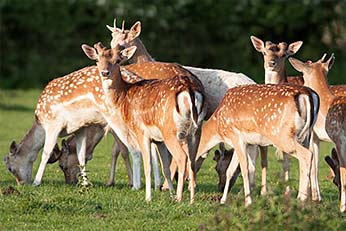
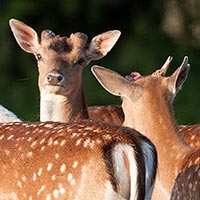
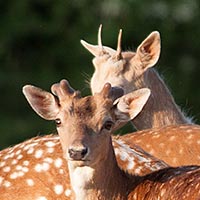
In the New Forest, only male deer, the stags and bucks, have antlers, the familiar solid bone structures grown annually and used for both defence and attack, and also to impress females and deter the presence of other males, during the deer’s breeding season, or rut.
Indeed, the stags’ and bucks’ annual cycle can be said to begin when the previous year’s antlers are cast off – in May for red deer, fallow deer and sika deer, around November for the earlier breeding roe deer, and between May and July for Reeves muntjac deer.
Replacement antlers start to grow almost immediately, but for a short while males are almost indistinguishable from females until the new antlers start to push through from the pedicles, the permanent, protruding stumps that are part of the skull.
Providing a degree of protection and also carrying nutrients and oxygen to the new antlers, a layer of initially soft, hairy skin covers the growing bone. It looks a bit like fur, and is known as velvet, so at this time the deer are said to be ‘in velvet’.
A full size set of antlers on a large stag or buck takes up to 15 or 16 weeks to form, after which the blood supply to the bone is cut off, and the velvet dies back and is rubbed off on convenient tree trunks or over-hanging branches. Whilst old velvet is present, the deer are said to be in ‘tatters’.
As the annual fallow, red, roe and sika deer ruts approach, the physical condition of stags and bucks changes, equipping them better for the tussles ahead - necks thicken and strengthen, thigh muscles become better developed, and Adam’s apples bulge. A persistent, pungent rutting odour is also noticeable as each animal becomes increasingly aggressive towards its fellows.
The timing of the rut varies for each species.
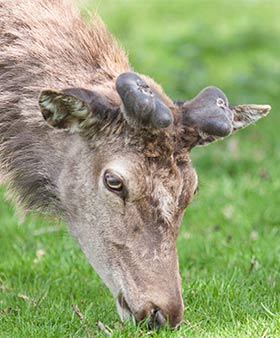
antlers 'in velvet'
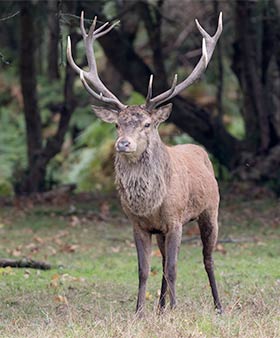
stag during the rut
In red deer, the rut starts around the third or fourth week of September, whilst for fallow deer the start is in early to mid-October. For both species, it lasts around 4 weeks.
The sika deer rut also occurs in the autumn, but is often more prolonged, less concentrated than that of red deer and fallow deer.
Roe deer breed considerably earlier than the others – their rut takes place in late July and early August – but a system of delayed implantation of the blastocyst into the uterine wall means that births take place at broadly the same time as the other species.
Reeves muntjac do not have a fixed breeding season and can produce two litters - of one youngster - in a calendar year with births at seven month intervals.
Fallow, red, roe and sika deer births take place from late May to the middle of June, synchronised to take advantage of abundant food supplies and extensive ground cover.
Red deer, fallow deer and sika deer normally give birth to single youngsters, whilst, outside the New Forest, roe deer often give birth to twins, and very occasionally triplets. In the New Forest, however, where competition from other deer and commoners’ stock reduces food availability, roe deer usually give birth to a single kid.
Youngsters remain under cover for their first few weeks of life; are weaned at around 4 months of age, although they may intermittently continue to suckle beyond this time but are not dependent on milk; and subsequently often remain in company with mum until the next year’s young are due to be born. They then leave her side, or are driven away, to make space for the new arrival. It’s not unusual, though, to see small winter groups of fully grown does, and current and previous year’s youngsters, so maybe some teenagers eventually return to the fold.
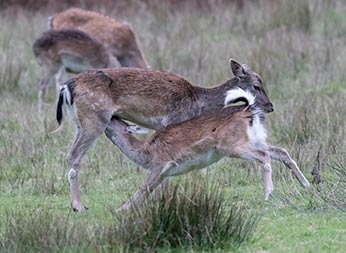
Stags and bucks generally make poor fathers. In fact they make poor companions generally.
Roe bucks and Sika stags in the New Forest tend to be fairly insular creatures that for most of the year seem to keep very much to themselves. Sika hinds, though, particularly in autumn and winter, can often be seen in small, single sex groups, whilst in some places elsewhere, Sika stags also congregate for much of the year in their own single sex groups.
Red deer and fallow deer herds, however, virtually always split into separate, single sex groups soon after the end of the rut, and do not usually come together again until just before the following year’s rut. Indeed, many red deer stags often leave the New Forest altogether, and spend much of their time on adjacent farm or parkland, or even in the relatively nearby Ringwood Forest.
New Forest deer - find out lots more
References:
The History of British Mammals: Derek Yalden
Deer Watch: Richard Prior
New Forest Roe deer: John K. Fawcett
Roe deer: John K. Fawcett
Sika deer: Rory Putman
Fallow deer: Jochen Langbein and Norma Chapman
More links
Other related links
Search this site

Sadly, 58 animals were killed - 35 ponies, 13 cows, 8 donkeys and 2 sheep, whilst a further 32 were injured - 3 pigs, 9 donkeys, 11 cows and 9 ponies.
(Forty-three accidents occurred in daylight, 15 at twilight and 101 in the dark. Twenty-seven accidents were not reported by the driver involved).
Here's just one horrific example - Three donkeys killed in collision with van at notorious New Forest blackspot (Advertiser and Times)

